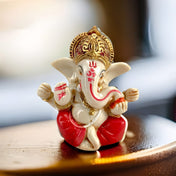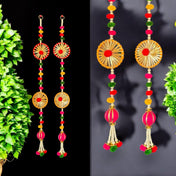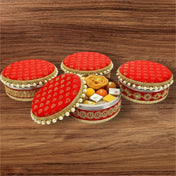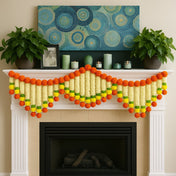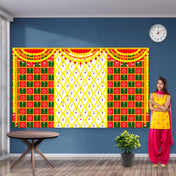Introduction
Rangoli is a vibrant and intricate traditional Indian art form that brings color and joy to festivities. This expressive craft involves creating stunning designs on the ground using various materials, symbolizing auspiciousness and welcoming guests. With its growing popularity in the US, Rangoli is embraced not just as an art but as a cultural bridge that fosters connections among diverse communities.
In this article, we explore The Art of Rangoli: Colorful Tips and Techniques for Stunning Rangoli Designs. Readers will discover:
- The beauty and purpose of Rangoli in Indian culture
- Essential materials needed for making your own designs, such as our flax fur yarn wool Ganesha Rangoli mat or an acrylic flower Rangoli set with Meenakari work
- Step-by-step techniques suitable for beginners and advanced artists alike
- Popular styles and regional variations that enrich this art form
- The incorporation of seasonal themes and symbolism into your creations
- Practical tips for starting your first Rangoli project
Join us in celebrating this enchanting tradition, where creativity meets cultural significance, inspiring you to create your own masterpieces that illuminate any occasion. Whether it's using a handmade Rangoli mat or a faux fur yarn wool Rangoli mat, we provide all the resources you need to embark on this colorful journey.

1. Understanding the Beauty of Rangoli
Rangoli is a vibrant and intricate art form that holds a cherished place in Indian culture. Defined as decorative patterns made on the ground using colored powders, rice, or flower petals, Rangoli serves both aesthetic and spiritual purposes. It is traditionally created during festivals and special occasions to welcome guests and invoke divine blessings.
The history of Rangoli can be traced back to ancient texts such as the Ramayana and Mahabharata. These epics not only depict scenes of artistry but also emphasize the significance of beauty and creativity in human expression. Historical references suggest that Rangoli was initially used to mark auspicious spaces within homes, fortifying the bond between art and spirituality.
This traditional practice embodies communal spirit and creativity. Families often come together to create stunning Rangoli designs, fostering connection and collaboration among community members. The process encourages artistic expression while serving as a medium for storytelling—each design may represent different motifs inspired by nature, mythology, or regional traditions.

Cultural Significance
Rangoli transcends mere decoration; it symbolizes joy, prosperity, and an invitation for positive energy into homes. The designs often feature motifs like flowers, geometric patterns, and symbols representing deities, enhancing the spiritual ambiance during celebrations. Each region in India has its unique style of Rangoli, reflecting local customs and artistic influences.
Engaging in Rangoli-making nurtures creativity while honoring cultural heritage. As this beautiful tradition gains popularity in places like the United States, it offers an opportunity for cross-cultural exchange and appreciation of Indian art forms. By embracing Rangoli, individuals can connect with its rich history while creating visually stunning masterpieces that resonate with personal stories and experiences.
For those looking to incorporate this beautiful tradition into their homes or celebrations, various Rangoli sets are available online. From handcrafted rose rangoli sets to DIY reusable rangoli mat kits, these products make it easier than ever to bring the beauty of Rangoli into your own home. Additionally, items like decorative flower rangolis or faux fur yarn wool flower rangoli mats can add a unique touch to any festive occasion.

2. Materials You Need to Get Started with Rangoli Making
Creating stunning Rangoli designs begins with selecting the right materials. Here’s a comprehensive overview to help you embark on your artistic journey.
Essential Materials
- Colored Powders: These are the cornerstone of any Rangoli design. Available in vibrant hues, look for powders made from natural sources such as:
- Rice flour: Produces a soft texture and is biodegradable.
- Turmeric: Offers a rich yellow hue, known for its auspicious significance.
- Chili powder: Adds a striking red color for those bold designs.
- Natural Materials: Incorporating organic elements enhances authenticity and beauty. Consider:
- Flower petals: Fragrant and colorful, they add a delicate touch. You can even use lotus flower cutout DIY Rangoli decorations for an elegant touch.
- Grains: Pulses or rice can be used creatively, offering texture and depth.
Tools for Rangoli
The right tools elevate your design from simple to stunning. Gather these essentials:
- Stencils: Perfect for beginners, they provide guidance for intricate patterns. A good option would be a 12-inch reusable MDF Rangoli mat with a 10-color kit.
- Chalk: Ideal for sketching outlines before filling in colors; it allows easy corrections.
- Funnels or Cones: Excellent for precision work; these help create fine lines and detailed shapes.
- Platter Mats: Patola platter reversible Diwali Rangoli floor mat can be a fantastic tool for creating intricate designs while also serving as a decorative item.
Additional Resources
For those keen on experimenting, various online platforms offer tutorials and templates to inspire creativity. Engaging with digital resources can enhance your skills while embracing traditional techniques.
Equipped with these materials and tools, including options like handcrafted wooden Rangoli decoration sets or Meenakari Rangoli hangings, you are ready to explore the enchanting world of Rangoli making. The next step lies in mastering techniques that will bring your vision to life.
3. Mastering Techniques for Stunning Rangoli Designs
Creating stunning Rangoli designs involves a blend of creativity and technique. This section provides a step-by-step guide to help you craft a basic yet beautiful Rangoli, while also offering insights into advanced methods for seasoned artists.
Step-by-Step Guide for Beginners
- Select Your Design: Start with a simple geometric pattern or floral motif. Sketch your design lightly on the ground with chalk to serve as a guide.
- Gather Your Materials: Utilize colored powders, flower petals, or grains to fill in your design. Choose colors that complement each other for an eye-catching effect.
- Start Filling: Begin from the center of your design and work outward. Use your fingers or a funnel to control the flow of the powder, ensuring clean lines.
- Add Details: Incorporate delicate elements like dots or swirls using contrasting colors. These small details enhance the overall aesthetic.
Techniques for Advanced Artists
- Layering Colors: Experiment with layering different colors to create depth in your design. This technique adds richness and complexity.
- Using Stencils: For intricate patterns, consider using stencils. Place them on the surface and fill them with your chosen materials for precision.
- Incorporating Natural Elements: Blend traditional motifs with modern designs by integrating natural elements like leaves or flower petals as highlights around your Rangoli.
- Experimenting with Texture: Explore various textures by mixing powders with different grains or flower petals to add dimension to your art.
Creative Expression
The beauty of Rangoli lies in its ability to reflect personal style and cultural heritage. Each design is an expression of creativity, bridging tradition with contemporary aesthetics. As you develop your skills, don't hesitate to adapt techniques and incorporate your unique flair into every creation.
Engaging in this artistic process not only deepens your understanding of Rangoli techniques but also enriches the experience of celebrating Indian culture through vibrant designs that resonate within communities.
For those looking to further enhance their Rangoli creations, consider investing in high-quality materials such as the Diwali acrylic rangoli set decorative pooja floor rangoli which are handmade, reusable, and perfect for festive home decor.
4. Exploring Popular Styles and Regional Variations of Rangoli
Rangoli reflects the rich tapestry of Indian culture, showcasing various regional styles that each carry unique significance and techniques. As you embark on this colorful journey, discover how these diverse forms of Rangoli can inspire your own creativity.
Kolam
Originating from South India, Kolam is known for its intricate patterns made using rice flour or colored powders. The designs are typically drawn on the ground at the entrance of homes as a welcoming gesture. You can explore these beautiful patterns further in our Kolam / Muggu Decor & Gifting Collection, which features both traditional and modern designs.
Technique
Kolam is characterized by its geometric patterns, often featuring flowing curves and dots. Artists use a continuous line to create stunning designs.
Cultural Significance
It is believed that Kolam invokes prosperity and good fortune, enhancing both the aesthetic appeal and spiritual ambiance of a space.
Mandana
Mandana, prevalent in Rajasthan, embraces the use of natural materials such as red clay mixed with chalk for vibrant designs. These Rangolis often feature motifs inspired by nature and traditional Rajasthani art.
Technique
Mandana designs are typically created using a combination of hand-drawn patterns and stencils. Bold outlines filled with contrasting colors enhance their visual impact.
Cultural Significance
This style embodies the spirit of celebration and community bonding during festivals, reflecting the artistic heritage of Rajasthan.
Other Regional Styles
India’s regional diversity brings forth various other styles worth exploring:
- Alpana from Bengal features elaborate floral designs often used during weddings.
- Aipan from Uttarakhand uses white rice paste to create sacred motifs for worship.
Engaging with these distinctive styles allows American artists to delve into a world where tradition meets personal expression. Adapting these techniques can lead to innovative interpretations that celebrate cultural heritage while fostering creativity in your own home.
5. Infusing Seasonal Themes and Symbolism into Your Rangoli Designs
Rangoli is not just an art form; it serves as a vibrant expression of cultural themes and seasonal motifs, especially during significant festivals. Creating Rangoli designs that reflect these celebrations adds depth and meaning to your artwork.
Common Festival Themes
1. Diwali
Known as the Festival of Lights, Diwali is celebrated with intricate Rangoli designs featuring:
- Diyas (lamps): Symbolizing the victory of light over darkness. You can enhance your Diwali celebration with a Diya Rangoli decoration set, which serves as a perfect decor gift.
- Flowers: Representing beauty and purity, often used in various colors to create lively patterns.
2. Pongal
A harvest festival from South India where motifs often include:
- Rice grains: Symbolizing abundance and prosperity.
- Sugarcane: Associated with sweetness and joy.
Symbolism Behind Popular Motifs
Incorporating seasonal elements into your Rangoli designs enhances their significance. Here are some common symbols and their meanings:
- Lotus: Represents purity and enlightenment. It can be beautifully rendered in vibrant hues to signify growth.
- Peacock: A symbol of grace and beauty, peacock motifs add a touch of elegance, often seen during weddings or joyous occasions.
- Om Symbol: A sacred sound in Hinduism, using this symbol in your designs conveys spirituality and peace.
When designing your Rangoli, consider the following tips for integrating seasonal themes:
- Choose a Theme: Select a festival or season as your inspiration.
- Research Motifs: Understand the symbolism behind traditional motifs to deepen the narrative of your design.
- Play with Color: Use colors that represent the emotions associated with the festival—warm tones for joy, cool tones for tranquility.
Infusing these seasonal motifs into your Rangoli not only beautifies your space but also creates a connection with cultural heritage. This practice allows every artist to celebrate their creativity while embracing rich traditions.
For those looking to add more charm to their Diwali celebrations, consider exploring unique Diwali gift boxes or personalized Diwali gifts that include beautiful Rangoli designs as part of the decor.
6. Tips for Beginners: Getting Started with Your First Rangoli Project
Creating your first Rangoli design can be an exciting journey into the world of vibrant colors and intricate patterns. Follow these essential tips to ensure a successful start.
Choosing the Right Location
- Flat Surface: Select a clean, flat area where your Rangoli will stand out. A porch or entrance is ideal as it welcomes guests.
- Visibility: Ensure the chosen spot is visible to everyone. This enhances the communal spirit, inviting admiration and appreciation.
- Lighting: Adequate lighting is crucial. Natural light or well-lit areas help highlight the colors and details of your design.
Preparing the Area
- Clean the Surface: Sweep away dust and debris to provide a smooth canvas. A clean surface allows colors to adhere better, resulting in clearer patterns.
- Outline Your Design: Use chalk or rice flour to lightly sketch the desired design before filling in with colors. This helps maintain proportions and symmetry.
Simple Design Ideas for Newcomers
Starting with easy designs can build confidence and inspire creativity:
- Geometric Patterns: Squares, circles, and triangles form beautiful foundations. Experimenting with basic shapes allows for exploration without intimidation.
- Floral Motifs: Simple flower designs are perfect for beginners. Try creating a lotus or marigold using vibrant colors that symbolize joy and prosperity.
- Diyas (Lamps): Incorporate diyas into your design. Their shape is easily recognizable, adding cultural significance while enhancing visual appeal.
Building Confidence
- Practice Regularly: The more you practice, the more comfortable you will feel with techniques. Start small and gradually take on more complex designs.
- Experiment with Colors: Play around with various color combinations to find what resonates with your style. Bright hues create lively expressions while pastels evoke calmness.
Through careful preparation and simple designs, you can embark on your Rangoli-making journey with confidence. Embrace this traditional art form as a means of personal expression while connecting with cultural heritage.
7. Taking Your Skills to the Next Level: Advanced Techniques for Experienced Artists
Creating intricate designs in Rangoli not only showcases artistic flair but also reflects a deep understanding of traditional patterns. For artists ready to elevate their skills, consider these professional tips and techniques:
Complex Patterns to Explore
- Mandala Designs: These circular patterns represent unity and harmony. Start from the center and work outward, incorporating geometric shapes and floral motifs.
- Peacock Feathers: Symbolizing grace and beauty, peacock feather designs require precision. Use contrasting colors to make the feathers pop.
- Symmetrical Designs: Mastering symmetry can challenge even seasoned artists. Begin with a simple outline, ensuring both sides mirror each other perfectly.
Tools for Intricacy
- Fine Nozzles: Using a funnel with a fine nozzle allows for detailed work in colored powders, creating sharp lines and delicate details.
- Stencils: Pre-made stencils can assist in achieving precise shapes. They are particularly useful for complex motifs like lotus flowers or intricate borders.
Protecting Your Work
Intricate designs often face the risk of smudging or fading. To ensure your creations last longer:
- Fixatives: A light spray of fixative can protect your Rangoli from environmental factors. Choose a natural fixative that does not alter the vibrancy of the colors.
- Edging Techniques: Incorporate rice flour or chalk around your design's perimeter. This not only enhances aesthetics but also serves as a barrier against dust.
Final Touches
Adding elements such as diyas (lamps) or fresh flower petals transforms your Rangoli into a living art piece. Consider incorporating seasonal themes or motifs relevant to upcoming festivals.
This exploration of advanced techniques encourages experienced artists to push their creative boundaries, crafting stunning designs that resonate with tradition while embracing personal expression.
8. Embracing Technology: The Role of Digital Tools in Modern-Day Rangoli Making
In an age where technology seamlessly integrates with creativity, digital tools have emerged as invaluable assets for Rangoli enthusiasts. These innovative resources enable artists to explore their creativity and refine their skills in exciting new ways.
Digital Tools for Designing Rangoli
Several apps and websites provide virtual templates, allowing users to experiment with designs before committing to physical materials. Some notable digital tools include:
- Rangoli Design Apps: These applications offer a plethora of traditional and contemporary patterns that can be customized according to one’s preferences.
- Online Design Platforms: Websites like Canva provide templates that can be adapted for creating Rangoli-inspired graphics, perfect for planning your next masterpiece.
- 3D Modeling Software: For the artist looking to push boundaries, 3D modeling tools allow you to visualize intricate designs from multiple angles.
However, not all design needs can be met through digital means. For those who prefer a hands-on approach, DIY Rangoli stencils are an excellent resource. These reusable templates come in various designs, making it easy to create stunning Rangolis with minimal effort.
Online Tutorials as Learning Resources
The rise of online tutorials has made learning accessible for everyone. Various platforms provide step-by-step guides, catering to all skill levels:
- YouTube Channels: Many talented artists share their expertise through video tutorials, demonstrating techniques ranging from basic patterns to advanced designs.
- Social Media Platforms: Instagram and Pinterest are treasure troves of inspiration, featuring countless posts showcasing unique Rangoli styles and methods. Engaging with these communities can spark new ideas and foster connections.
- Dedicated Websites & Blogs: Many cultural websites offer comprehensive guides on Rangoli-making techniques, along with tips on materials and themes.
These digital resources empower artists to enhance their skills while embracing the rich tradition of Rangoli in a modern context. As technology continues to evolve, it opens doors for creative expression that respects cultural heritage while inspiring innovative approaches.
9. Cultural Exchange Through Art: Bringing Bangali Tradition to America with LoveNspire's Mission!
Art forms like Rangoli serve as powerful mediums for cultural appreciation, fostering an understanding of diverse traditions. LoveNspire embodies this spirit through its commitment to bridging cultural gaps by offering authentic ethnic products from India, enriching lives through the beauty of craftsmanship.
Key aspects of LoveNspire’s mission include:
- Promoting Diversity: By celebrating the art of Rangoli, LoveNspire encourages individuals to embrace the rich tapestry of Indian culture. The intricate patterns and vibrant colors invite engagement and curiosity.
- Authentic Ethnic Products: Every product at LoveNspire reflects a story rooted in tradition. This approach not only preserves heritage but also introduces these treasures to new audiences in America.
- Community Involvement: Americans can actively participate in this cultural exchange during festivals or community events. Engaging with Rangoli workshops or exhibitions organized by brands like LoveNspire allows for hands-on experiences that deepen appreciation for this beautiful tradition.
Through these initiatives, LoveNspire fosters meaningful connections between cultures, ensuring that the art of Rangoli continues to flourish in new and inspiring ways.
Conclusion: Celebrate Diversity Through Artistic Expression!
Celebrating diversity through artistic expression brings people together in unique and meaningful ways. Rangoli, as a vibrant representation of Indian culture, transcends geographical and cultural boundaries. Engaging with this art form opens doors to understanding the rich history and traditions behind it.
- Explore Personal Connections
- Each design created resonates with the artist’s emotions, stories, and heritage. Take time to reflect on your own experiences and how they can influence your Rangoli designs. This personal touch enriches the artwork, making it a true reflection of identity.
- Cultural Enrichment
- Embracing Rangoli not only allows for creative expression but also fosters appreciation for diverse cultures. As you learn about the various styles and techniques, you are partaking in a larger narrative that honors both tradition and innovation.
- Community Engagement
- Participating in community events centered around Rangoli can deepen relationships with others who share similar interests or seek to learn about Indian culture. The act of creating together cultivates a sense of belonging and unity.
Artistic expressions like Rangoli invite everyone to join in the celebration of culture, encouraging exploration and connection through creativity.
Get Started With Your First Rangoli Project Today!
Discover the vibrant world of Rangoli and let your imagination soar! Whether you're just starting out or looking to enhance your skills, LoveNspire has a carefully selected collection designed for those eager to practice this beautiful art form.
Explore Our Collection
- Beginner Kits: Find all essential materials needed to create stunning designs.
- Guides and Tutorials: Access resources that provide step-by-step instructions for your first project.
Share Your Creations
Celebrate your artistic journey by sharing your Rangoli masterpieces on social media. Use our dedicated hashtags to connect with fellow enthusiasts and inspire others in the community.
Ready to Dive In?
Explore more about Rangoli and how you can incorporate this vibrant tradition into your life. Your journey into the art of Rangoli starts today—embrace the colors, the culture, and the creativity that enriches our lives.
Get started today! Create meaningful connections through The Art of Rangoli: Colorful Tips and Techniques for Stunning Rangoli Designs.










